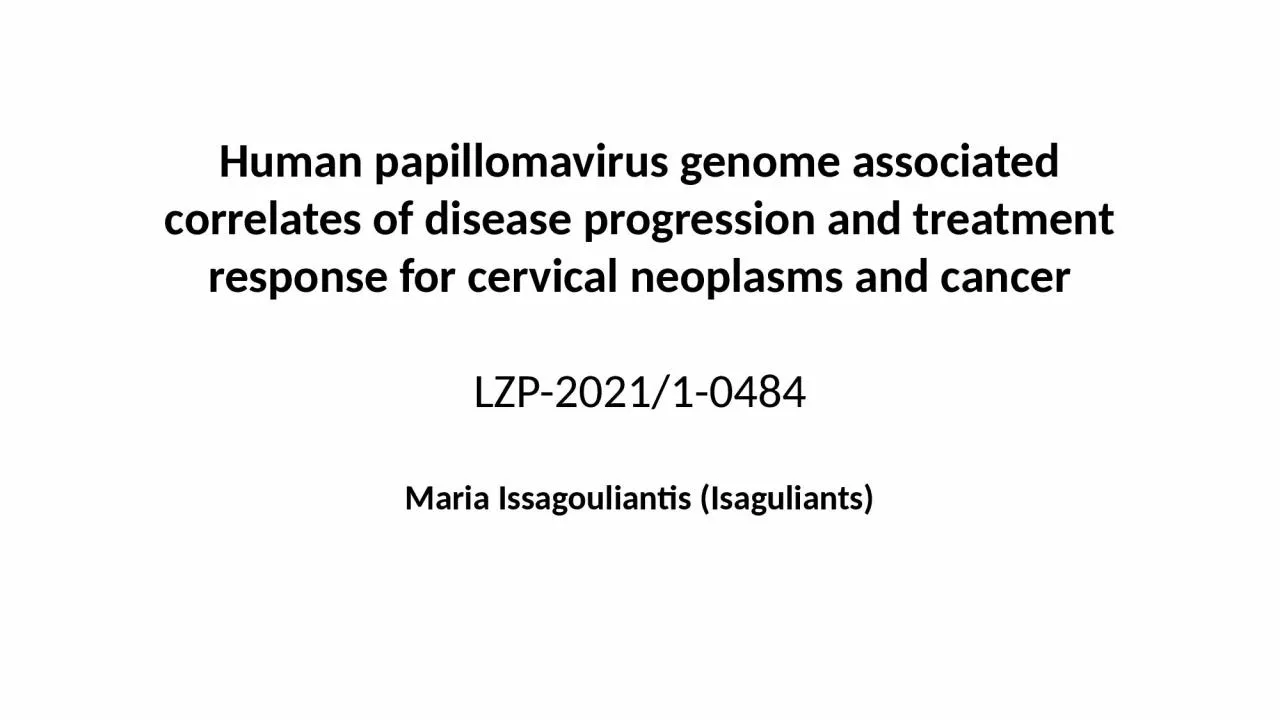

LZP202110484 Maria Issagouliantis Isaguliants Partner RSU Maria Issagouliantis leading researcher Androniks Mitildzans MD Arta Spridzane MD Ilvija Uzulina medical nurse Juris Jansons researcher ID: 1048466
Download Presentation The PPT/PDF document "Human papillomavirus genome associated c..." is the property of its rightful owner. Permission is granted to download and print the materials on this web site for personal, non-commercial use only, and to display it on your personal computer provided you do not modify the materials and that you retain all copyright notices contained in the materials. By downloading content from our website, you accept the terms of this agreement.
1. Human papillomavirus genome associated correlates of disease progression and treatment response for cervical neoplasms and cancerLZP-2021/1-0484Maria Issagouliantis (Isaguliants)
2. Partner RSUMaria Issagouliantis, leading researcherAndroniks Mitildzans, MDArta Spridzane, MDIlvija Uzulina, medical nurseJuris Jansons , researcherLiba Sokolovska, researcher, PhD studentAlesja Dudorova (internship, completed)Karina Biserova (internship)Partner Paul Stradins University HospitalJurijs Nazarovs, Specialist in Pathology, MD, PhDAustra Breiksa, MD (2022-2023)Daira Krisande, MD (2023-2024)Svetlana Gebrila, laboratory assistant
3. Circulating genotypes of human papilloma virusesAlpha-9: HPV 16, 31, 33, 35, 52, and 58Alpha-7: HPV 18, 39, 45, 51, 59, and 68Alpha-5, 6: HPV 53, 56, 66, and 69
4. PROJECT AIMS Genotype HR HPVs in healthy and diseased cervix and determine prevalent genotypes; Indentify eventual genotype drift;Characterize evolution of dominant strains (epitopic drift);Assess degree of DNA damage due to HPV integration.
5. Study includes women with squamous intraepithelial lesions and carcinomas and matching controls (40 each). Women with squamous intraepithelial lesions and carcinomas (n=40)Squamous intraepithelial lesions HSIL (n=20)- n=10-15, Jurijs N., from Paul Stradins University Hospital dated before 2015n=10-15 from clinical follow up, Androns M dated from 2021 on. Sample collection and sreenings 1-4(5) – smears, bipsies, materials from conizationSquamous cell carcinomas (n=20, Jurijs N. from Paul Stradins University Hospital collection) dated before 2015 (n=10) dated after 2016 (n=10) Newly collected (n=100) Screenings 1-4(5) Every 6 month after primary investigation – semars, bipsoies, excised tumor materials.Follow up after surgery - month 3, month 9, month 15, month 21-22 (year left before project completion, one more screening is possibleMatching conditionally healthy controls (n=40)from clinical follow up, Androns M dated from 2021 (n=40 for start)Every 8-10 month after primary investigationCervical smear collection and screenings 1-3(4) Month 3, month 12, month 22, (year left before project completion, one more screening is possible - month 30-32).
6. Cervical smears (on-going) 80 primary + 40*3=120 conditionally healthy follow up + 40*3=120 HSIL & CSSC follow up, totally 350 samples during 24 month.Collection - cervical brush, conservation of material, transfer for PCR analysis in sets of 20-30 samples at a time (10-12 runs in total). Samples would be kept in preservation material in the freege for >month )Liquid cytometry – Subcontracts with Centrala Laboratorija and Gulbja Laboratoria. Diagnosis confirmation DNA extraction + HR HPV specific PCR (kits) Subcontracts with Centrala Laboratorija and Gulbja Laboratoria.
7. Cervical biopsies and resected material of tumors (done) 40 from collection, unknown number from the prospective study – expected to be approx 20Collection - formalin fixation 1-2 days 4% formalin, transfer to PBS, paraffinization Immunohistochemistry of biopsies and sections from conization materials and resected tumors for p21, p53– Paul Stradins University Hospital DNA extraction Sectioning FFPE blocks, DNA extraction QUIGEN kits. Aliqoting, deep freezing of the aliqotes.HR HPV specific PCR of extracted DNA (Q PCR for 15 HR HPVs)
8. Genotype HR HPVs in healthy and diseased cervix - 2023 (done)Determine prevalent genotypes on newly collected samples – after each screening – 20* 5=100 HSIL samplesIn biobank HSIL and SCCC samples from earlier years – before 2015, after 2016 – max 40 SCCC samplesIn total, 140 samplesConditionally healthy – 40 pts * 2-4 visits HR HPV PCR in totally 300 samples during two years.Define two dominant HR HPVs – HPV16 and ?? (HPV 56, or 58, or 52??)Now we know that it is HPV31 in conditionally healthy, and HPV33 in cancer
9. Characterize evolution of dominant strains (started)L1 as most variable capsid, E6 and E7 as oncoproteins defining chronic infection & malignization – attempt Sanger sequening in all 1st and last samples from the dominant strains. HPV 16 – 100% in cancer, 10-15% in general population. Other HR HPV – 10% max, of total 80 – 10 early and 10 late samples. 20 sequencing runs.Subcontract arranged for the whole RSU, experiments to be done in 2024.Will receive approx 40 sequences of E6 and E7 of HR HPV 16 and one more HR HPV.In sequential samples, and in newly collected vs biobanked samples:Genotype drift Epitopic drift in L1, E6, E7
10. HPV whole genomic sequencing (WGS) - 2024Quality of DNA in stored samples, HPV WGS where amount of HR HPV DNA permits (independently of HR HPV genotype)HPV genomic sequencing in samples with sufficiently good DNA quality and amount of HPV DNA (approx n=10)Search for human-HPV DNA chimeras and insertions of full lenght oncogenes E6 and E7 (have preliminary data to publish; findings here will be in support)HPV-human DNA chimeras resulting from HPV integration will be quantified and their quantitiy and localization compared in patient withDifferent course/outcome of HPV infectionPatients with different HR HPV genotypesDepending on epitopic drift
11. In vitro experiments will assess the effect of typical HPV DNA inserts on tumorigenic & metastatic portential of expressing epithelial cellsE6E7 expressing murine adenocarcinoma cells already establishedMetabolism (mitochondrial respiration & glycolysis)Motility (wound healing assay)Doubling time, colony formation on soft agarTumorigenicity and metastatic activity in vivo in syngenic miceAssessment of the effects of E6E7 expression on tumor cells.Effects of longitudinal E6E7 expression on genonic stability by WGS of E6E7 expressing adenocarcinoma cells after short (10 passages) and long passaging (>40).E6/E7 based DNA vaccines against HR HPVs (optional)
12. OutcomesIdentification of early markers predisposing to malignization to personalize treatment and prevent development of cervical cancer:Epitopic drift Degree of DNA damage Rates of HR HPV clearance and reinfectionEvaluation of the direct tumorigenic effects of E6 and E7 expression on the epithelial cells in the absence of interference of p53 (4T1luc2 cells are p53(-)).
13. Thank you for your attention!